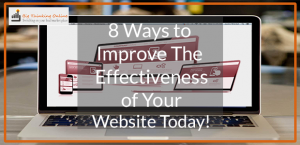
Flickr: @michaelandannabel
Marketing has come a long, long way. The advent of digital media channels completely revolutionized the way create, distribute, and consumer media. With this tectonic shift, new forms of content became available to marketers of all types.
In the early 2000’s, the dot com bubble bursted, and many thought online retail would go with it. A significant portion of tech companies that went bust in that time period were focused on eCommerce. In retrospect, the obvious reason for their demise, beyond being insanely overvalued, was that the technology available at the time could not perform the functions necessary to create a functional user experience.
2015 is much different than 2001. eBay and Amazon survived and thrived after the hi-tech collapse; they learned from the mistakes of others, and strived to create platforms that fully met the needs of online shoppers.
As other retail companies, including big box stores, saw the potential of online shopping, they too jumped on the band wagon. Today, we are also seeing large brands themselves creating an online shopping experience on their own websites.
Taking queues from traditional shopper marketing strategies, online retailers and brands have put significant resources into the promotion and marketing of online sales.
User Generated Content (UGC) has emerged as a driving force in the world of eCommerce. The modern-day consumer spends countless hours scouring the web for information about a product, and he or she places significantly more trust in fellow consumers rather than the word of a brand or company.
As on off-shoot of UGC, consumer generated video content can now be seen as a dominant aspect of a UGC strategy. Powerful statistics, like the fact that having UGC video on your retail site can boost online sales by 30%, have driven this point home to marketers. Additionally, studies reveal that just a single text review on a product page can increase sales by 10%.
By leveraging the trust that UGC instills in the consumer, brands can identify and nurture Brand Connected Consumers in order to reach a critical mass of consumer activation. By cultivating relationships with Brand Connected Consumers, brands can ensure they will receive more positive UGC about their product.
Many larger brands have embraced consumer generated video content as an integral part of any online retail strategy, but many have not; even the brands that have, still don’t quite understand best practices and how to fully leverage its benefits.
There are 5 main aspects to a consumer generated video strategy for brands:
1. Creators

A brand needs to have a large community of video content creators that will be able to tap into. These creators should be authentic consumers; people who will actually use and speak honestly about a product, for good or bad.
It’s important that a strategy is created for identifying the right creator for each product and making sure they are on message and create aspirational content. This can be incredibly difficult for a brand to do on their own, which is why there are solutions out there that help streamline this process.
2. Video Types

The most important type of consumer generated video for brands who are selling products online is product reviews. Video reviews leverage the increased trust that consumers give to other consumers, and video is the most persuasive form of content. Other types of consumer generated video content include how-to videos for products, and opinions. By leveraging all three, a brand will maximize the full potential of consumer video.
3. Distribution
Once consumer generated video is accumulated, it needs to be placed on points of purchase in a way that is easily viewable. It’s extremely important that this placement happens by the time a product launches – a successful initial product launch is a great indicator of on-going sales.
By far, the most valuable channel for retail is Amazon. Getting quality, consumer generated video content on to product pages on Amazon will cause a substantial increase in overall sales. Again, getting this content on product pages by day one of a product launch is crucial; timing is everything.
There are also more qualitative benefits to including video, namely that even those consumers who plan on purchasing at a brick and mortar location often do most of their research online.
Beyond Amazon, placement on big retailers such as Target and Walmart, as well as on a brand’s own site, is also key.
Don’t forget about YouTube! Consumer generated content need not only live on retail sites, it can also be distributed to the number one video site in the world. The two main strategies for YouTube distribution of consumer video content are:
- Leverage influencer’s YouTube channel for more visibility
- Utilize a brand’s own YouTube channel
4. Search Optimization

Consumer video can help optimize search in both Google and Amazon. That’s right, Amazon Search Optimization. Think about it, a consumer is in the market for makeup. He or she is going to go to Amazon and search a generic keyword such as “makeup,” wouldn’t a brand want to have a video associated with their product placed at the top of the results?
5. Paid Media
Content, of any kind, should never be used just once. After putting all that blood, sweat, and tears into accumulating quality consumer generated content it can be highly beneficial to leverage it for paid media. An example would be taking a short review video and adding it as a pre-roll ad on YouTube.
Have your own strategy for launching new products online utilizing UGC? Leave your comments below.
(236)



